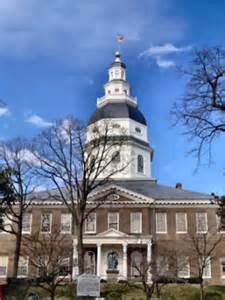
LEGISLATIVE BRANCH
The Legislative Branch consists of the Maryland General Assembly and its supporting agencies. The General Assembly is
the Maryland legislature. Sometimes, the General Assembly is considered the
"popular" branch of government, because its members more directly represent the
electorate than do officials of either the executive or judiciary. Legislators
are elected to both houses of the General Assembly from legislative election districts
redrawn every ten years after the federal census to ensure equal representation,
based on the concept of "one person, one vote." Geographical size of the
districts varies according to population density.
The General Assembly passes all laws necessary for the welfare of the State's
citizens and certain laws dealing with the counties and special taxing
districts. It also determines how State funds are to be allocated; and adopts
amendments to the State Constitution, subject to ratification by the
voters. Bills may be introduced in either house. When passed by both houses and
signed by the Governor, bills become law. Current laws are compiled in the
Annotated Code of Maryland.
Senate & House of Delegates.
Like all states but Nebraska, Maryland has a bicameral legislature. The lower
house is the House of Delegates and the upper house is the Senate. Representatives to both
houses are elected in each gubernatorial election year for four-year terms.
Candidates for the House of Delegates must be at least twenty-one years of age
and those for the Senate at least twenty-five. The House of Delegates consists
of 141 members, while the Senate has 47 members. Both houses convene annually on
the second Wednesday in January for a 90-day session. Sessions may be extended
by resolution of both houses, and special sessions may be called by the
Governor. The Governor also may be petitioned by the Legislature to call a
special session.
Committees. To facilitate its work during
and between sessions, the General Assembly refers work to various
committees. Among these are standing committees which consider and make recommendations regarding proposed
legislation. They also include joint committees, often
statutory committees, made up of members from both the Senate and House of Delegates.
Legislative Agencies. The legislative branch also encompasses the
Department of Legislative Services. The Department assists in the
preparation of legislation and maintains information services essential for
legislators and the public. Additionally,
the Department prepares financial impact statements and monitors fiscal
functions for the General Assembly.
Budget. One of the single most
important tasks of the General Assembly, and one that requires close
coordination and consultation with the Executive Branch, is adoption of the
annual budget for Maryland State government.
The Constitution specifies that it is the responsibility of the Governor to
present the annual budget to the General Assembly within five days of the
beginning of each legislative session. The budget of Maryland must be balanced -
it must not exceed anticipated revenues (Const., Art., III, sec. 52). This
requirement prevents deficit spending and accounts in large part for the
excellent bond rating enjoyed by the State. Reflecting the principle of
separation of powers within State government, the Governor must incorporate into
the budget unchanged requests from the legislative and judicial departments, as
well as the estimated expenses required for operating the public schools. Beyond
these items and other obligations for certain State debts and the salaries of
officials specified in the Constitution, the Governor has considerable
discretion in determining what programs and agencies to fund in the budget. The
budget process thus is a major policy-shaping tool for the Governor.
Supplemental budgets may be submitted by the Governor after adoption of the
annual budget, but all requests for such funds must be matched by additional
anticipated revenues.
